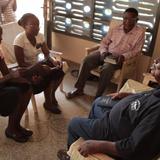Candace Richins was in the midst of her freshman season with Utah State University’s women’s volleyball team when the announcement came from Church President Thomas S. Monson: women can serve missions at age 19 and men at 18. Although thrilled about the possibility of serving a mission earlier, Richins — a possible starter on the team in 2013 — worried because her scholarship and spot on the team would not be guaranteed if she left.
| Missionaries speak with a woman in Hong Kong. In response to the 6 October 2012 announcement of lower age requirements for missionaries, mission presidents across the globe are preparing for increased numbers by training their missionaries who are already serving so they can train incoming missionaries. 2013 Intellectual Reserve, Inc. All rights reserved. | 1 / 9 |
A few days later, while in a religion class near campus, Richins knew what she needed to do.
“I felt very impressed that I needed to go and I needed to go now,” says Richins, who will begin missionary service in March in Stockholm, Sweden. “So I decided right then and there that I would go and it didn't matter what I was leaving behind; I would just go and serve the Lord. It definitely was a hard decision because it not only affects me, it affects my coach, my teammates, the whole school. … But at the same time, I knew that it was right and that what I was doing was the correct thing and that everyone would be blessed for it.”
Like Richins’ experience, the decision to drop everything is not easy for any young man or woman in the Church. Nevertheless, the response to the 6 October announcement remains enthusiastic as unprecedented numbers of young men and women continue to fill out missionary applications.
“I've never seen anything affect a generation of young people like what President Monson announced the Saturday morning of general conference,” says Elder David F. Evans, executive director of the Church’s Missionary Department and member of the Seventy. “What we're seeing is just an absolute overwhelming response from this generation to the invitation of the Lord and His prophet to rise up and go and serve your fellow man and preach the gospel.”
In the weeks following the missionary age announcement, the Church reported that missionary applications had increased dramatically (from 700 applications per week to 4,000), with women comprising more than half of the applicants. While the number of post-announcement applications is still double what it has been in the past, the total number of men and women who have applied since October is now about equal. Prior to the announcement, approximately 15 percent of missionaries were young women.
Downloadable HD broadcast-quality of the missionary VNR (without graphics, for news media use)
What the Church is doing to accommodate more missionaries
The Church operates 347 missions around the world, each with an average of 170 missionaries. To accommodate this new influx of missionaries, capacity for many missions will rise to 250 missionaries. When missions exceed that number, new missions will likely be created as needed.
Speaking to missionaries at the Provo, Utah MTC on Christmas Day, Elder Russell M. Nelson of the Quorum of the Twelve Apostles dispelled false rumors that missions were opening in areas not currently open to missionary work. “Such rumors are absolutely false. Refute them!” Elder Nelson said. "Leaders of this Church enter countries new to the Church through the front door. We do not go in through the back door or via the alley. Our relationships are based on honesty, openness, integrity and complete compliance with local law."
Mission presidents are preparing for increased numbers by training their missionaries who are already serving so they can train incoming missionaries. Mission presidents are also looking at how they can best deploy missionaries within each mission’s boundaries. While the responsibility placed on mission presidents will increase, Elder Evans notes that it won’t be overwhelming.
“We’ve had many missions that have been 220 to 250 missionaries over the history of the modern Church in different places,” he says.
Because the Church has allowed some missionaries in 48 countries to serve at 18 for the past several years, the greatest surge of missionaries from the October announcement will come from countries where the younger age limit was not in place — including the United Kingdom, the United States, Canada and Japan.
Adjustments will also be made at each of the Church’s 15 missionary training centers (MTCs). Training time for same-language and foreign-language missionaries will be reduced by 30 percent — those not learning a language will be at the MTC for two weeks instead of three, and those learning a language will have two weeks cut from their MTC stay.
(Download broadcast-quality b-roll of the missionary training center (MTC) for news media use)
Two recent developments make reduced MTC time possible. First, the Church initiated a 12-week in-field missionary training program a year ago — before anyone knew of the coming age announcement — in which much of the training that occurs at the MTC is retaught and reinforced in the mission field. Second, the Church initiated a study several months prior to the missionary age announcement that shows that it is possible to improve a missionary’s ability to learn a second language by sending him into the field earlier. These two changes would have occurred with or without the missionary age announcement.
To increase MTC capacity, each training center is maximizing empty space, including putting more bunk beds in each room. For example, the Church’s flagship MTC in Provo, Utah, will increase capacity from 3,000 to 4,800 in the short term. Long-term plans are also being considered. Although in mid-October Church leaders decided to not move forward with the construction of a nine-story building originally proposed for the Provo MTC, plans are still in the works to increase the center’s long-term capacity.
“Not demolishing the buildings that would’ve been demolished to build that nine-story building has proven to be a great blessing in the short term,” Elder Evans says, “because anything we would’ve done would’ve decreased capacity in the short term.”
Although many more missionaries will be at the MTC at one time with the same facilities, Missionary Department managing director Stephen B. Allen says the MTC experience for each missionary will be equally good, if not better.
“[We want] to make sure that the MTC experience for every missionary will be a great experience,” Allen says. “It won’t be a watered-down experience; it won’t be a cheapened experience. It will be a great spiritual learning experience, a time of revelation for those missionaries as they learn how to be missionaries.”
Downloadable HD broadcast-quality of the missionary Q&A
Gratitude for flexibility in university enrollment options
The impact of the missionary age announcement also has a significant impact on enrollment numbers at universities in Utah and elsewhere.
Elder Evans notes that the Church is deeply grateful to university administrators who have taken steps to accommodate young men and women who choose to serve.For example, at the end of November the University of Utah announced a new enrollment deferment policy that allows students to defer the start of their schooling for up to seven semesters. And in October Utah State University appointed a task force that is currently considering strategies the university can implement to best adapt to those who choose to serve a mission.
“The accommodation made by the universities has just been wonderful,” Elder Evans says. “Their willingness to consider the position of the Church and then seek the admission of the young people of the Church with the hope they’ll come back to those institutions after their missions has been very, very gratified, and we would be remiss if we didn’t express appreciation to every university that’s making that effort.”
Richins says her missionary service will help her be a better student when she returns.
“I hope that when I get back I’ll be different, I’ll be changed,” she says. “I’ll work harder, be more diligent in school, develop more of my talents, and I hope that it just develops me more as a person.”
Miranda Rechis, who also has taken advantage of the lower age requirement and will soon be a missionary in Osorno, Chile, agrees. She says missionary service will help her “mature, to be able to take … college seriously” when the mission is over.
More opportunities for missionary service
It’s no secret that many more young women have volunteered for missionary service since 6 October. Church leaders are grateful for their willingness to serve. In a press conference following the announcement, Church apostle Jeffrey R. Holland said he is “absolutely delighted if this change in policy allows many, many more young women to serve,” noting that “those [women] who do serve are stunningly successful.”
Church leaders are also thrilled in general that more of the Church’s young people — men and women — will now be able to serve missions.
“This is an invitation of love from the Lord to this entire generation,” Elder Evans says. “What I would also say is that the scriptures make it clear, and I think the First Presidency and the Twelve have made it clear, … that we are all equal before God."










